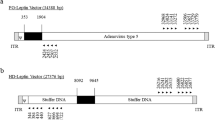Abstract
We have designed new vectors for the construction of recombinant adenoviruses containing expression cassettes in the E1 and/or E3 regions. Using a versatile set of restriction enzymes, the cassettes are cloned into small bacterial vectors and subsequently introduced into large plasmids containing the adenoviral sequences. Two positive selection markers facilitate the recovery of a cosmid containing a copy of the sequence of the recombinant adenovirus. The resulting cosmid is transfected into 293 or 911 cells in order to rescue the virus. Importantly, the method does not require any recombination event, either in E. coli or in mammalian cells. The entire procedure can generate viral plaques in 12 days.
This is a preview of subscription content, access via your institution
Access options
Subscribe to this journal
Receive 12 print issues and online access
$259.00 per year
only $21.58 per issue
Buy this article
- Purchase on Springer Link
- Instant access to full article PDF
Prices may be subject to local taxes which are calculated during checkout





Similar content being viewed by others
References
Robbins PD, Tahara H, Ghivizzani SC . Viral vectors for gene therapy Trends Biotechnol 1998 16: 35–40
Kochanek S et al. A new adenoviral vector: replacement of all viral coding sequences with 28kb of DNA independently expressing both full-length dystrophin and β-galactosidase Proc Natl Acad Sci USA 1996 93: 5731–5736
Hardy S et al. Construction of adenovirus vectors throughcre-lox recombination J Virol 1997 71: 1842–1849
Kozarsky KF, Wilson JM . Gene therapy: adenovirus vectors Curr Opin Genet Dev 1993 3: 499–503
McGrory WJ, Bautista DS, Graham FL . A simple technique for the rescue of early region I mutations into infectious human adenovirus type 5 Virology 1988 163: 614–617
Imler JL et al. An efficient procedure to select and recover recombinant adenovirus vectors Gene Therapy 1995 2: 263–268
Schaack J, Langer S, Guo X . Efficient selection of recombinant adenoviruses by vectors that express β-galactosidase J Virol 1995 69: 3920–3923
Davis AR, Meyers K, Wilson JM . High throughput method for creating and screening recombinant adenoviruses Gene Therapy 1998 5: 1148–1152
Miyake S et al. Efficient generation of recombinant adenoviruses using adenovirus DNA–terminal protein complex and a cosmid bearing the full-length virus genome Proc Natl Acad Sci USA 1996 93: 1320–1324
Ketner G et al. Efficient manipulation of the human adenovirus genome as an infectious yeast artificial chromosome clone Proc Natl Acad Sci USA 1994 91: 6186–6190
Chartier C et al. Efficient generation of recombinant adenovirus vectors by homologous recombination in Escherichia coli J Virol 1996 70: 4805–4810
Fu S, Deisseroth A . Use of cosmid adenoviral vector cloning system for the in vitro construction of recombinant adenoviral vectors Hum Gene Ther 1997 8: 1321–1330
Crouzet J et al. Recombinational construction in Escherichia coli of infectious adenoviral genomes Proc Natl Acad Sci USA 1997 94: 1414–1419
He TC et al. A simplified system for generating recombinant adenoviruses Proc Natl Acad Sci USA 1998 95: 2509–2514
Mizuguchi H, Kay MA . Efficient construction of a recombinant adenovirus vector by an improved in vitro ligation method Hum Gene Ther 1999 9: 2577–2583
Souza DW, Armentano D . Novel cloning method for recombinant adenovirus construction in Escherichia coli Biotechniques 1999 26: 502–508
Graham FL, Smiley J, Russel WC, Nairn R . Characteristics of a human cell line transformed by DNA from human adenovirus type 5 J Gen Virol 1977 36: 59–74
Catalano CE, Cue D, Feiss M . Virus DNA packaging: the strategy used by phage lambda Mol Microbiol 1995 16: 1075–1086
Fallaux FJ et al. Characterization of 911, a new helper cell line for the titration and propagation of early region 1-deleted adenoviral vectors Hum Gene Ther 1996 7: 215–222
Miwa T, Matsubara K . Lambda phage DNA sequences affecting the packaging process Gene 1983 24: 199–206
Bett AJ, Haddara W, Prevec L, Graham FL . An efficient and flexible system for construction of adenovirus vectors with insertions or deletions in early regions 1 and 3 Proc Natl Acad Sci USA 1994 91: 8802–8806
Tomanin R et al. Development and characterization of a binary gene expression system based on bacteriophage T7 components in adenovirus vectors Gene 1997 193: 129–140
Pützer BM et al. Interleukin 12 and B7–1 costimulatory molecule expressed by an adenovirus vector act synergistically to facilitate tumor regression Proc Natl Acad Sci USA 1997 94: 10889–10894
Bramson J et al. Construction of a double recombinant adenovirus vector expressing a heterodimeric cytokine: in vitro and in vivo production of biologically active interleukin-12 Hum Gene Ther 1996 7: 333–342
Oka A, Sugisaki H, Takanami M . Nucleotide sequence of the kanamycin resistance transposon Tn903 J Mol Biol 1981 147: 217–226
Birnboim HC, Doly J . A rapid alkaline extraction procedure for screening recombinant plasmid DNA Nucleic Acids Res 1979 7: 1513–1523
Gerard RD, Meidell RS . Adenovirus vectors. In: Hames BD, Gover D (eds) DNA Cloning: A Practical Approach Oxford University Press: Oxford 1995 pp 285–306
Cepko C . X-gal staining of cultured cells. In: Ausubel FM et al (eds). Current Protocols in Molecular Biology John Wiley: New York 1987 (Suppl.17): pp9.11.9–9.11.12
Acknowledgements
We gratefully acknowledge Drs E Chang, Y Laroche and D Salmi for critical review of the manuscript, and Dr RE Vestal for generous financial help.
Author information
Authors and Affiliations
Rights and permissions
About this article
Cite this article
Danthinne, X., Werth, E. New tools for the generation of E1- and/or E3-substituted adenoviral vectors. Gene Ther 7, 80–87 (2000). https://doi.org/10.1038/sj.gt.3301047
Received:
Accepted:
Published:
Issue Date:
DOI: https://doi.org/10.1038/sj.gt.3301047
Keywords
This article is cited by
-
An efficient method of directly cloning chimpanzee adenovirus as a vaccine vector
Nature Protocols (2010)
-
High throughput creation of recombinant adenovirus vectors by direct cloning, green-white selection and I-Sce I-mediated rescue of circular adenovirus plasmids in 293 cells
Gene Therapy (2003)
-
Production of first generation adenovirus vectors: a review
Gene Therapy (2000)



